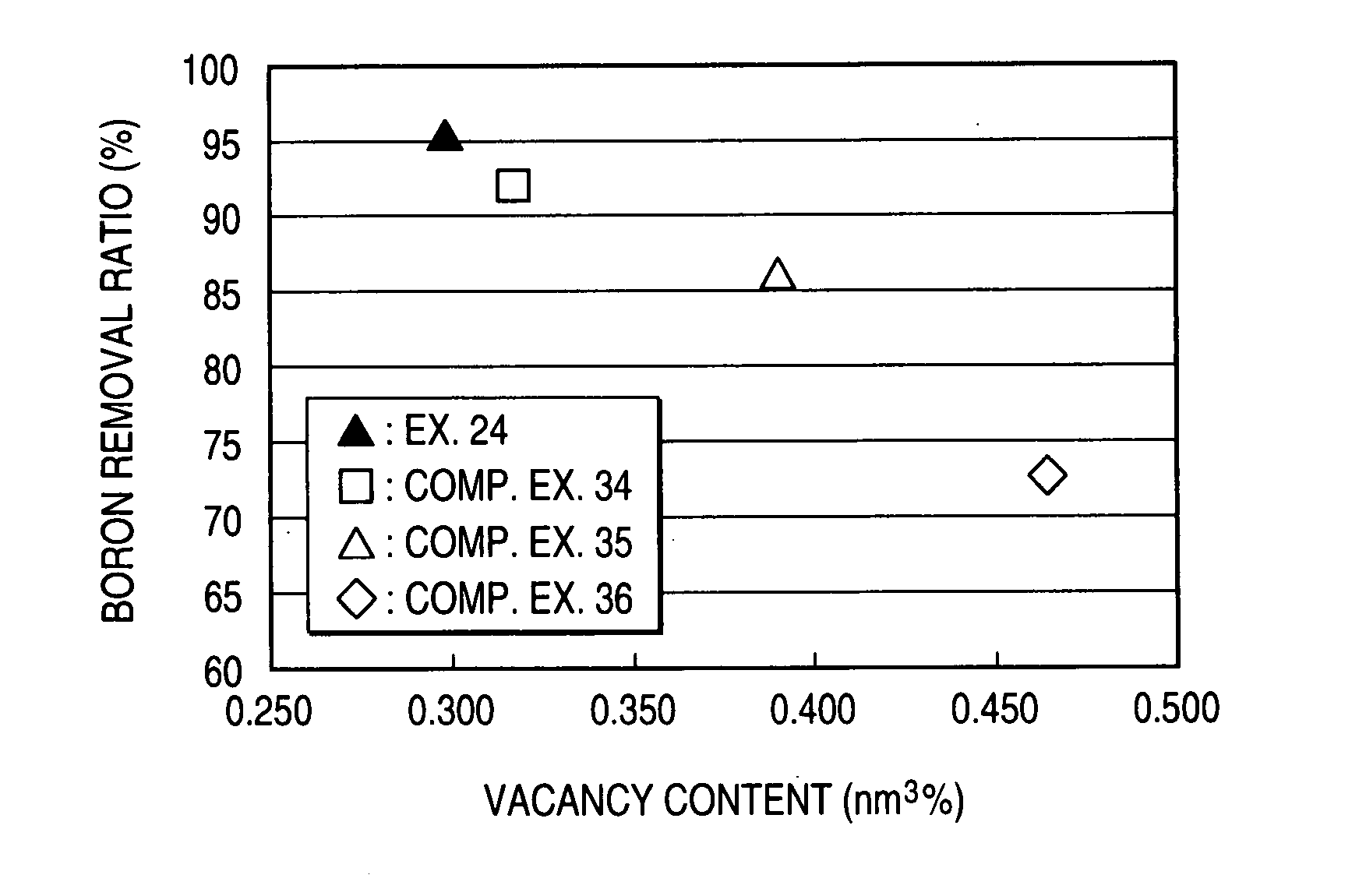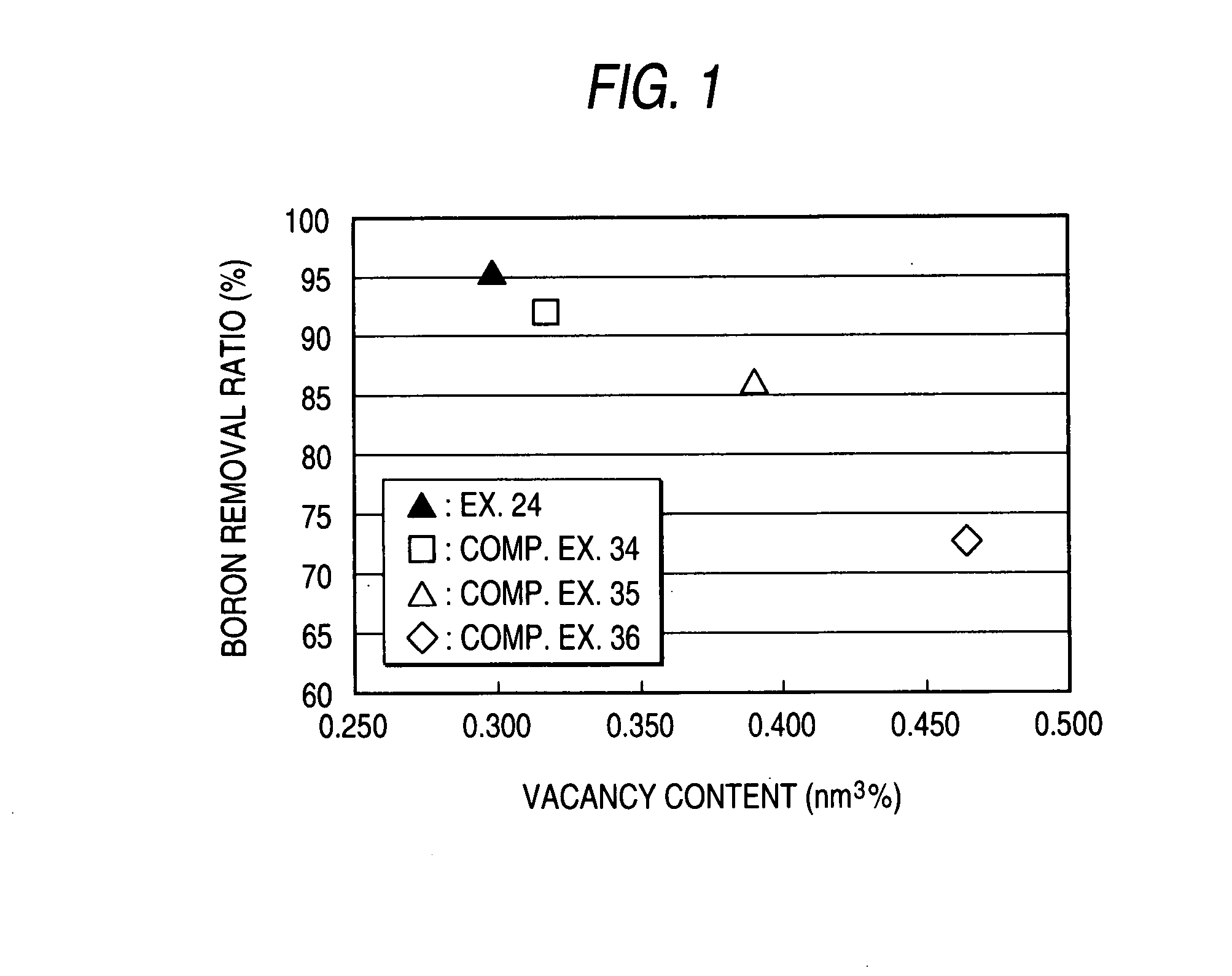Composite Semipermeable Membrane, Production Process Thereof, and Element, Fluid Separation Equipment and Treatment Method for Boron-Containing Water Using the Same
a semi-permeable membrane and semi-permeable technology, applied in the direction of membranes, filtration separation, separation processes, etc., can solve the problems of not being able to achieve the boron removal ratio of 95%, the water quality standard in the art is controlled more and more severely, and the boron removal ratio has not yet been improved to reach the level of 95%. , to achieve the effect of high salt removal ratio and high rejection performan
- Summary
- Abstract
- Description
- Claims
- Application Information
AI Technical Summary
Benefits of technology
Problems solved by technology
Method used
Image
Examples
reference examples 1 and 2
[0091] An N,N-dimethylformamide (DMF) solution of 15.3% polysulfone was cast on polyester nonwoven fabric (permeability: 0.5 to 1 cc / cm2·sec) at room temperature (25° C.) to a thickness of 200 μm, then immediately dipped in pure water and left therein for 5 minutes to prepare a porous substrate film. The thus formed porous substrate film (thickness: 210 to 215 μm) was dipped in an aqueous amine solution containing polyfunctional amine described in Table 1 for 2 minutes, then gradually pulled up in the vertical direction, exposed to nitrogen blow from an air nozzle to thereby remove the excess solution from the surface of the substrate film, and then an n-decane solution containing polyfunctional acid halide described in Table 1 was applied thereto so as to completely wet its surface, and kept as such for 1 minute. Next, the film was vertically held for 2 minutes so as to remove the excess solution from it, and the film was dewatered. Next, this was washed with hot water at 90° C. fo...
reference example 3
[0092] A composite semipermeable membranes was produced in the same manner as in Reference Examples 2, except for without dipping an aqueous solution of sodium hypochlorite which had been controlled to have a pH of 7 and a chlorine concentration of 200 mg / liter, for 2 minutes. The composite semipermeable membranes thus obtained were evaluated, and the membrane permeation flow rate, salt removal ratio, boron removal ratio and salt transmission coefficient are shown in Table 1.
TABLE 1MembraneSaltBoronSaltAcH—AlpermeationremovalremovaltransmissionRef.PolyMono(mol ratioflow rateratioratiocoefficientEx.AmAmAcH—Arper AcH—Ar)(m3 / m2 / d)(%)(%)(×10−8 m / s)1mPDANoneTMCNone1.0599.8889.701.4623.4%0.15%OC0.014% (20 mol %)0.6299.8193.281.373OC0.014% (20 mol %)0.4999.7493.701.48
examples 1 to 22
[0093] A water-soluble organic material described in Table 2 was dissolved in water to reach a definite concentration to prepare a solution. If necessary, about 10% of isopropyl alcohol was added thereto. Each of the composite semipermeable membranes obtained in Reference Examples 1 to 3 was dipped in this aqueous solution at room temperature for a definite time. Then, the membrane was washed with pure water to obtain a new composite semipermeable membrane. The composite semipermeable membranes thus obtained were evaluated, and the membrane permeation flow rate, salt removal ratio, boron removal ratio and salt transmission coefficient are shown in Table 2.
PUM
| Property | Measurement | Unit |
|---|---|---|
| pressure | aaaaa | aaaaa |
| pH | aaaaa | aaaaa |
| mean pore radius | aaaaa | aaaaa |
Abstract
Description
Claims
Application Information
 Login to View More
Login to View More - R&D
- Intellectual Property
- Life Sciences
- Materials
- Tech Scout
- Unparalleled Data Quality
- Higher Quality Content
- 60% Fewer Hallucinations
Browse by: Latest US Patents, China's latest patents, Technical Efficacy Thesaurus, Application Domain, Technology Topic, Popular Technical Reports.
© 2025 PatSnap. All rights reserved.Legal|Privacy policy|Modern Slavery Act Transparency Statement|Sitemap|About US| Contact US: help@patsnap.com



